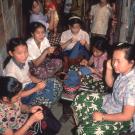HSS 2.1,
HSS 2.5,
RF.2.4,
SL.2.1,
SL.2.6,
L.2.1,
L.2.3,
L.2.6,
SL.2.2,
SL.2.3,
RL.2.1,
RL.2.2,
RL.2.3,
RL.2.4,
RL.2.5,
RL.2.6,
RL.2.7,
RL.2.9,
RL.2.10,
RI.2.1,
RI.2.2,
RI.2.3,
RI.2.4,
RI.2.5,
RI.2.6,
RI.2.7,
RI.2.9,
RI.2.10,
L.2.4
This lesson identifies important places that were relevant to this unit’s family of the Sierra Valley Wel-mel-ti, and events affecting this family and many Native Americans of this era. Carmelita’s older brother, Wilbur Smith, grew up traveling between Loyalton, Long Valley, and Susanville, California. Although not mandated for his area, Wilbur chose to attend Sherman Indian Boarding School, far south in Riverside, California. Students will learn about his challenging experience growing up in these places, and consider the period of Indian boarding schools where children attended far away from their loved ones, as well as the fact of being drafted into World War II at the age of 16. To better understand geography for the Sierra Valley Wel-mel-ti, students will complete mapping activities to become familiar with the traditional Washoe territory, and the 3 different bands of Washoes.




